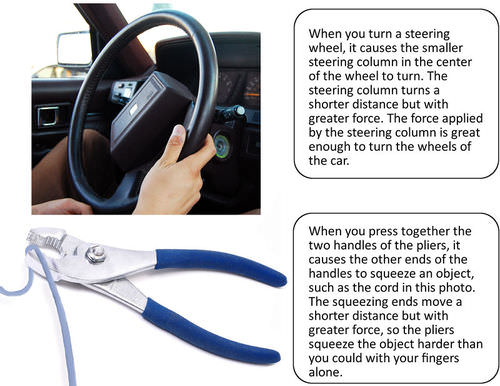What is a machine and How Machines Make Work Easier?
Last updated on July 8th, 2021 at 05:48 am
When we hear the word machine, images of power tools or construction equipment come into our minds. While these are certainly some examples of machines, devices as simple as hammers and screws are also machines. Why are simple tools like hammers and screws considered to be machines? Because like all machines, they also change forces and make work easier.
What is a Machine?
A machine is any device that makes work easier by changing a force. A machine can do this by increasing the output force, or by increasing the output distance, and sometimes by changing the direction of the input force.
Work is done whenever a force moves an object over a distance. The amount of work done is represented by the equation: Work = Force x Distance.
Output force vs Input force: When we use a machine, we apply force to the machine. This force is called the input force. The machine, in turn, applies force to an object. This force is called the output force. The output force may or may not be the same as the input force.
Output distance vs Input distance: The force we apply to the machine is applied over a given distance, called the input distance. The force applied by the machine to the object is also applied over a distance, called the output distance. The output distance may or may not be the same as the input distance.
How Machines Make Work Easier
It is to be noted that, machines do not increase the amount of work that is done. They just change how the work is done. Machines make work easier by increasing the amount of force that is applied, or by increasing the distance over which the force is applied, and some machines also help by changing the direction in which the force is applied.
If a machine increases the force applied, The machine must apply the force over a shorter distance. That’s because a machine doesn’t change the amount of work and work equals force times distance. Therefore, if force increases, the distance must decrease. For the same reason, if a machine increases the distance over which the force is applied, it must apply less force.
Note:
So, when Output force > Input force, that means Output distance < Input distance
And, when Output force < Input force, that means Output distance > Input distance
Machines Make Work Easier – By Increasing Force
Examples of machines that increase force are steering wheels and pliers (see Figure below). In each case, the machine applies more force than the user applies to the machine, but the machine applies the force over a shorter distance. For this type of machine, the MA (mechanical advantage) is more than 1. [ Read more about Mechanical Advantage ]

[Figure 1]
Machines Make Work Easier – By Increasing Distance
Examples of machines that increase the distance over which force is applied are leaf rakes and hammers (see Figure below). In each case, the machine increases the distance over which the force is applied, but it reduces the strength of the force. For this type of machine, the MA (mechanical advantage) is less than 1.

[Figure 2]
Machines Make Work Easier – By Changing the Direction of Force
Some machines change the direction of the force applied by the user. They may or may not also change the strength of the force or the distance over which the force is applied. Two examples of machines that work this way are the claw ends of hammers and flagpole pulleys. You can see in the Figure below how each of these machines works. In both cases, the direction of the force applied by the user is reversed by the machine.

[Figure 3]
Q: If the pulley only changes the direction of the force, how does it make the work of raising the flag easier?
A: The pulley makes it easier to lift the flag because it allows a person to pull down on the rope and add his or her own weight to the effort, rather than simply lifting the load.
Simple and Compound Machines
There are six types of simple machines that are the basis of all other machines. They are the inclined plane, lever, wedge, screw, pulley, and wheel, and axle.
The six types are pictured in the Figure below.
Most machines are combinations of two or more simple machines. These machines are called compound machines. An example of a compound machine is a wheelbarrow (see the last item of Figure 4 below). It consists of two simple machines: a lever and a wheel and axle.
A complex machine is a combination of two or more simple machines. The wire cutters combine two levers and two wedges. Bicycles include wheel and axles, levers, screws, and pulleys. Cars and other vehicles are combinations of many machines. See (figure 5) below for the image of the wire cutter.
Many compound machines are much more complex and consist of many simple machines. Examples include washing machines and cars.

[Figure 4]

Summary
- A machine is any device that makes work easier by changing a force.
- Machines may increase the strength of the force, increase the distance over which the force is applied, or change the direction in which the force is applied.
- There are six types of simple machines. Machines that consist of two or more simple machines are called compound machines.
Resource Reference & Images: https://flexbooks.ck12.org
